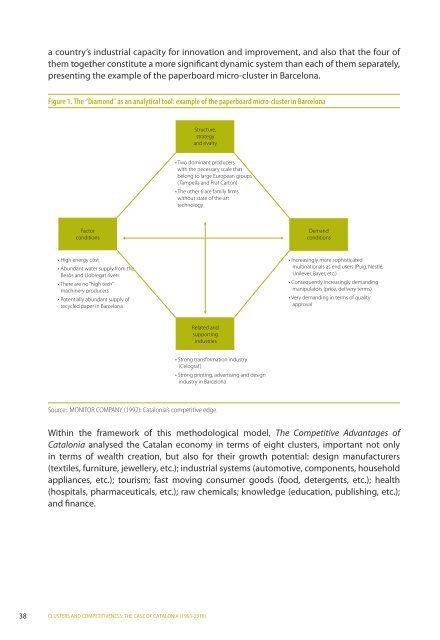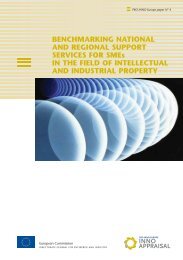Clusters and competitiveness - PRO INNO Europe
Clusters and competitiveness - PRO INNO Europe
Clusters and competitiveness - PRO INNO Europe
You also want an ePaper? Increase the reach of your titles
YUMPU automatically turns print PDFs into web optimized ePapers that Google loves.
a country’s industrial capacity for innovation <strong>and</strong> improvement, <strong>and</strong> also that the four of<br />
them together constitute a more significant dynamic system than each of them separately,<br />
presenting the example of the paperboard micro-cluster in Barcelona.<br />
Figure 1. The “Diamond” as an analytical tool: example of the paperboard micro-cluster in Barcelona<br />
Factor<br />
conditions<br />
• High energy cost<br />
• Abundant water supply from the<br />
Besòs <strong>and</strong> Llobregat rivers<br />
• There are no “high tech”<br />
machinery producers<br />
• Potentially abundant supply of<br />
recycled paper in Barcelona<br />
Structure,<br />
strategy<br />
<strong>and</strong> rivalry<br />
Related <strong>and</strong><br />
supporting<br />
industries<br />
38 CLUSTERS AND COMPETITIVENESS: THE CASE OF CATALONIA (1993-2010)<br />
• Two dominant producers<br />
with the necessary scale that<br />
belong to large <strong>Europe</strong>an groups<br />
(Tampella <strong>and</strong> Prat Carton)<br />
• The other 6 are family firms<br />
without state of the art<br />
technology<br />
• Strong transformation industry<br />
(Celograf)<br />
Source: MONITOR COMPANY (1992): Catalonia’s competitive edge.<br />
• Strong printing, advertising <strong>and</strong> design<br />
industry in Barcelona<br />
Dem<strong>and</strong><br />
conditions<br />
• Increasingly more sophisticated<br />
multinationals as end users (Puig, Nestlé,<br />
Unilever, Bayer, etc.)<br />
• Consequently increasingly dem<strong>and</strong>ing<br />
manipulators (price, delivery terms)<br />
• Very dem<strong>and</strong>ing in terms of quality<br />
approval<br />
Within the framework of this methodological model, The Competitive Advantages of<br />
Catalonia analysed the Catalan economy in terms of eight clusters, important not only<br />
in terms of wealth creation, but also for their growth potential: design manufacturers<br />
(textiles, furniture, jewellery, etc.); industrial systems (automotive, components, household<br />
appliances, etc.); tourism; fast moving consumer goods (food, detergents, etc.); health<br />
(hospitals, pharmaceuticals, etc.); raw chemicals; knowledge (education, publishing, etc.);<br />
<strong>and</strong> finance.
















